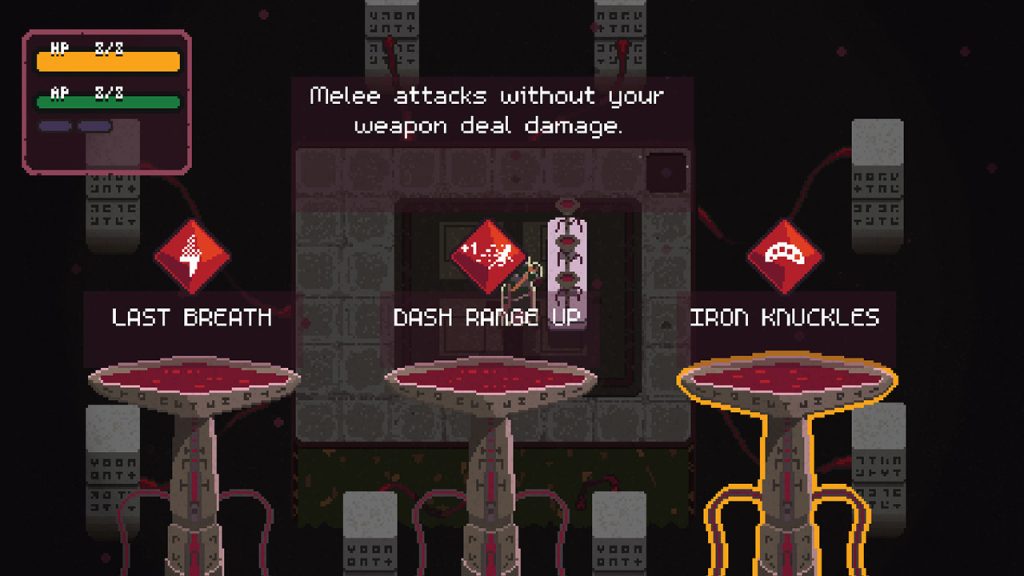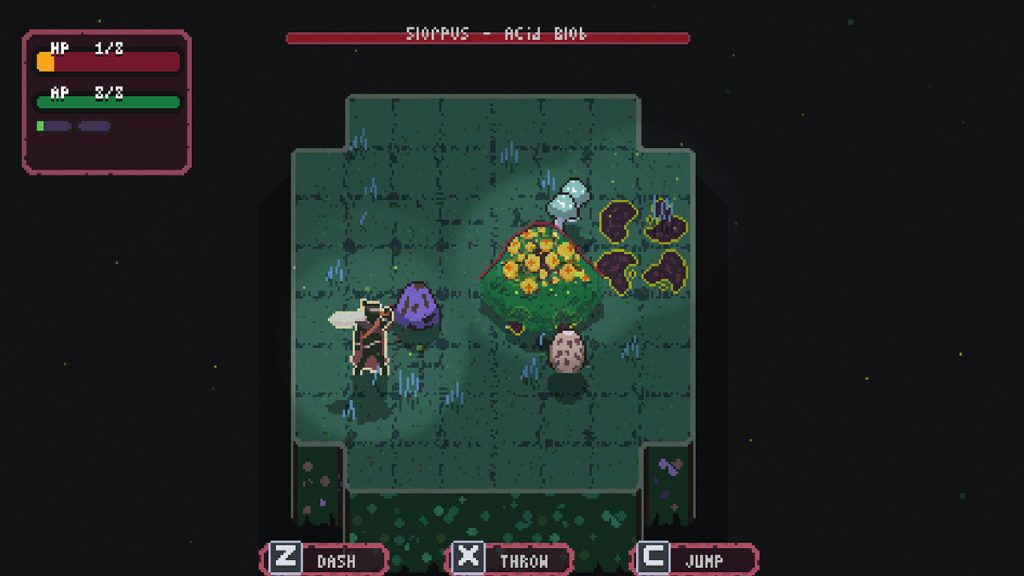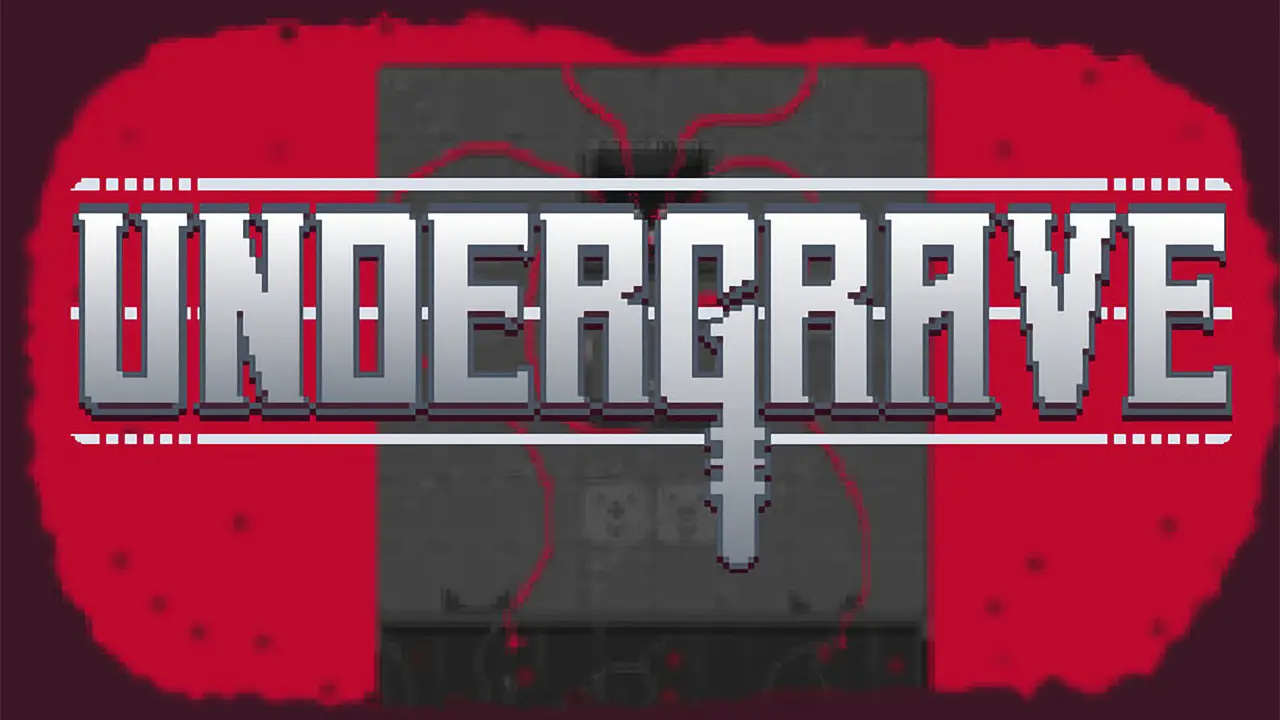Undergrave is a recent addition to the realm of 2D Roguelike Turn-based games and was developed and Published by Wired Dreams Studio. With a minimalist pixel art design, a soundtrack reminiscent of old-school games, and a hardcore strategy feel to it, Undergrave will have you enjoying figuring out all of its seemingly never-ending ways to play and survive.
The game stars you playing as a Knight roaming through the void realm, only this time, the void realm is made up of randomly generated rooms filled with squares to traverse and enemies that you must either kill or be killed by. Undergrave can be an interesting game to look at or watch someone play to pass the time, but now let’s talk about how it feels

Design Wise, It isn’t much
When it comes to the design aspect, Undergrave isn’t anything special, with pixel graphics and just one main soundtrack. Undergrave is not a particularly exciting visual or auditory experience. In fact, if you tried to rate it off just how it looks and sounds, you would be hard-pressed to find another game to devote the next three hours of your life to.
But in some ways, it feels to be an intentional choice. By spending less time on the designs and audio and more time on everything else, The developers were still able to create a game that had me propped on my chair for hours trying to figure out how to beat it.
That said, now let’s talk about how playthroughs felt.

Gameplay and The Mechanics
Gameplay in Undergrave is made up of a few parts:
- Abilities
- Health and AP
- Combat Strategy
After the game starts with the soundtrack, a retro-esque song that makes you think of old-school games, an intro pops up, and a narrator speaks via text to tell you ut the general setting you find yourself in. The intro is short yet skippable, a part of the game that does nothing to remove from the game’s overall feel but adds more substance to the theme and plot, which is very minimalistic in itself.
After the intro, if you skipped it like I did, you’ll find yourself at the game’s starting lobby. This lobby is where you get acquainted with the game’s main action set. Your Abilities as well as start your game.
Abilities
On your first visit to the lobby, you are met with a set of basic instructions on the screen. This includes three bars at the bottom that show your possible actions, the controls for each as well as their AP requirements. Each action takes a specific amount, depending on whether you have your weapon or not. And yes, this is a key feature I only realized after multiple playthroughs and deaths.
Your three main abilities, other than being able to move around, are:
- A dash that costs 3AP. It goes in one direction and can kill every enemy in your path (As long as you have your sword or pass through it before you reach the enemies)
- A throw that costs 2AP. This allows you to get ranged kills, but you end up barehanded until you can retrieve it.
- Finally, A Jump that costs 4AP and is a good way to kill enemies, stun them, and get away… most times.
These abilities and how you use them determine how you progress.

Health and AP
Your abilities and how many times you can use them are determined by your AP, among other things. Which refills by 1 point for each move you make without an ability.
Then, arguably more important, is your HP. Unlike your AP, which regenerates during your turns and after combat, your HP can only be refilled or increased when you get to one of the rest areas that appear after you beat four rooms, and even that is iffy. Because healing means forgoing an upgrade that could potentially help you beat future levels, you end up finding that you have to do your best to use everything to your advantage and protect your health bar.
Or at least that is how I do it.
Combat Strategy
Combat in Undergrave is intuitive and easy to understand but hard to master. After taking a look at the basic guide, when you start the game, you effectively know enough to start playing, but that is about it. Unlike most games, Undergrave doesn’t come with a help menu or move list, and that is what makes gameplay hard and all the more brutal.
Understanding just how combat works and how moves sync into one another is something you can only get properly after multiple playthroughs. This is also the major thing that gives Undergrave its replayability and makes you want to keep trying. The fact that you get a set amount of actions and then have to use those effectively is a challenge that I couldn’t resist but take, and you probably won’t be able to either.
Trail and error helped me understand that I could attack monsters when they were adjacent to me, but only if I was willing to get hit because they get first priority. So unless they are stunned, which you can do by jumping beside them, You have to be willing to take a hit before giving one. Experimenting also helped me find out that going to the next stage without my weapon left me barehanded, but also instakilled an enemy because the sword would drop on them.
Another Part of combat strategy, just like in other roguelikes, is that every four rounds, you get a chance to get an upgrade and save your progress( just in case you need to quit). But unfortunately, unlike most roguelikes, Undergrave doesn’t have any permanent upgrades or customizations from repeated runs. So other than the fact than the satisfaction that comes from beating a stage or getting further than your previous attempts, there isn’t much to mark your progress.
At the end of the day, strategy-wise, the game feels like a cross between hardcore chess against a grandmaster and a resource management game. You have to constantly be calculating not just your moves but that of your opponents as well. Every turn is spent silently weighing the pros and cons of each action before you take them.

How Balanced is Undergrave?
Well, balance and fun-wise, Undergrave leaves a lot to be desired. This is for a variety of reasons.
One is the fact that possible upgrades come once every four levels and only last for that run, and not just that, upgrades are randomized as well, and so picking an upgrade means forgoing something else, like more health. It also means that there are times when none if the possible upgrades are very appealing.
Part of me wishes that they took time out to make it so that killing enemies occasionally gives HP, especially considering how killing enemies occasionally makes AP boosters drop.
Another issue with Undergrave is the lack of customization. There’s nothing you can do to change how the game works or how the game looks to suit you. Everything is already set in stone. While that makes gameplay interesting for those who are fixed on trying to master the game’s limited actions and learn how to use them to their advantage. For more casual players, it might feel a bit bland.
The lack of customization and change even affects the scenery. Perhaps it was because I didn’t get to go past the first boss, but the level of monotony is a lot. Visually, there aren’t even slight changes in scenery, other than the positions of obstacles and opponents as well as yourself on the 2d board being randomly generated. Because of that games have a tendency to look the same, and after a while, playthroughs start to get a little boring on the visual front.

Conclusion
At the end of the day, when it comes down to it. Undergrave is a very enjoyable game. I spent hours trying to master the moves, learn new tactics and figure out better and better ways to come out on top. In fact, I still am!
Visually and even audibly, there isn’t a lot about Undergrave that strikes me as special. With the pixel graphics and one retro soundtrack, getting a little boring after a while. The major strengths of Undergrave line in the its mental engagement and strategy-focused combat. For people who love playing strategy games and enjoying the anticipation that comes with waiting to see if you can outmaneuver your enemies, Undergrave is sure to be a hit.
Especially considering its simplistic and intuitive controls and the fact that It gives room for experimenting and figuring out how to play rather than handing everything to you on a platter.
At the end of the day, Undergrave is an amazing, well-made game from Wired Dream Studios. One that every turn-based strategy game lover should try at least once. Because I did, and I loved it.
Pros and Cons
Pros
Strategy focused gameplay
Amazing Concept
Intuitive controls
Low spec requirements
Cons
No room for customisation
Visually Average
Playthroughs can occasionally feel monotonic.









